(1)The change in position of an object over the time is known as motion. Motion can be measure in terms of displacement, speed, acceleration, time.
Motion could be along straight line or periodic or circular.
Some examples of different types of motion
| Examples of motion | Type of motion
Along a straight line/circular/periodic |
| Soldiers in a march past | Along a straight line |
| Bullock cart moving on a straight road | Along a straight line |
| Hands of an athlete in a race | Periodic |
| Pedal of a bicycle in motion | Periodic |
| Motion of the earth around the sun | Circular and periodic |
| Motion of a swing | Periodic |
| Motion of a pendulum | Periodic |
(2)Types of motion
(i) If the speed of an object moving along a straight line keeps changing, its motion is called non- uniform motion.
(ii) If the motion of an object moving along a straight line with a constant speed is called uniform motion. In this case, the average speed is the same as the actual speed.
(iii) A motion by an object between extreme alternate within definite interval of time, is known as periodic motion or oscillatory motion.
Eg:- When the bob of the pendulum is released after taking it slightly to one side, it begins to move to and fro as shown in figure. The to and fro motion of a simple pendulum is an example of a periodic or an oscillatory motion.

(a)One oscillation is the distance completed by a bob of pendulum from its mean or extreme position and come back to same position from where it had started after reaching other (mean or extreme) positions.
(b)The time taken by any object to complete one oscillation is called its time period. Therefore, time taken by the pendulum to complete one oscillation is called its time period.
Experiment 2
Set a pendulum on the wall. Let the bob in rest and mark I on wall. Note time in stopwatch or any other watch. Now, move the bob to one side and displace it. Bob will start movement. Count 20 oscillations and note the time taken by bob to complete these oscillations.

Repeat this many time and note time in given table below.
Time period of a simple pendulum
Length of the string = 100 cm
| SN | Time taken for 20 oscillations | Time period (time taken/No. of oscillation) |
| 1. | 40 sec | 2 sec |
| 2. | 40.1 sec | 2.005 sec |
| 3. | 40.2 sec | 2.01 sec |
Yes, time period of pendulum is nearly the same in all cases.
(3)Nowadays, most clocks or watches have an electric circuit with one or more cells. These clocks are called quartz clocks. The time measured by quartz clocks is much more accurate than that by the cocks available earlier.
(4) All symbols of units of time and speed are written in singular.
Eg:- 50 kms is wrong practice of writing unit.
50 km is correct practice of writing units.
5 mins is wrong practice of writing unit.
5 min is correct practice of writing units.
(5) Many time measuring devices were used in different parts of the world before the pendulum clocks became popular.
Eg:- Sundials, water clocks and sand clocks.

Experiment 3
Draw a straight line on the floor with chalk. Ask your friend to roll a ball from the 1 or 2m along the floor perpendicular to the straight line. Note the time of ball when it crosses the line and when it comes to rest. Measure the distance between the straight line and the point where it comes to rest. Repeat this activity with other friends and record the measurement in the table given below. In each case calculate the speed of the ball.

Distance moved and time taken by a moving ball
| Name of the friend | Distance moved by the ball | Time taken (s) | Speed = Distance/ Time taken (m/s) |
| Ram | 1 m | 5 s | 1/5 = .2 m/s |
| Radha | 1.5 m | 6 s | 1.5/6=.25 m/s |
| Seema | 1.4 m | 5 s | 1.4/5=.28 m/s |
| Murlidhar | 1.5 m | 5 s | 1.5/5=.3 m/s |
Fastest speed that some animals can attain
| S N | Name of the object | Speed in km/h | Speed in m/s |
| 1. | Falcon | 320 | = 88.88 |
| 2. | Cheetah | 112 | = 31.11 |
| 3. | Blue fish | 40 – 46 | = 12.77 |
| 4. | Rabbit | 56 | = 15.55 |
| 5. | Squirrel | 19 | = 5.27 |
| 6. | Domestic mouse | 11 | = 3.05 |
| 7. | Human | 40 | = 11.11 |
| 8. | Giant tortoise | 0.27 | = .075 |
| 9. | Snail | 0.05 | = .013 |
(6) Distance covered = Speed × Time
Time taken = Distance/Speed

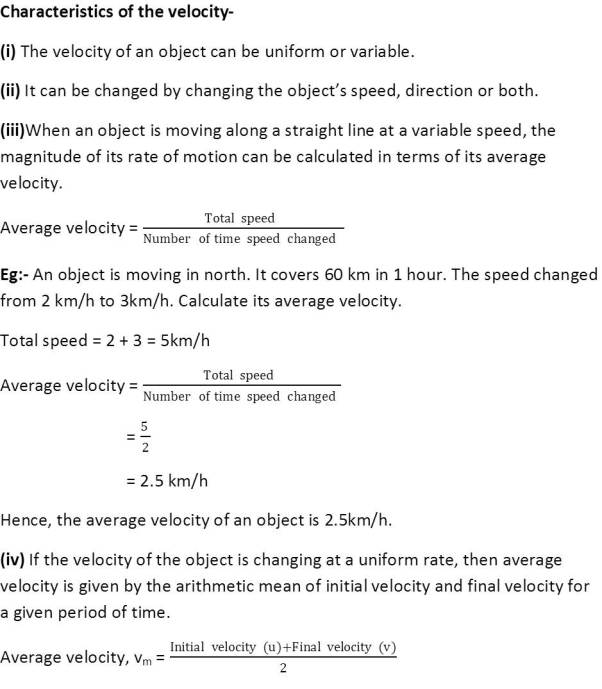
 (9) An instrument fitted in bikes and on the dash board of four wheeler which shows speed of the vehicle is known as speedometer. It measures speed in km/h.
(9) An instrument fitted in bikes and on the dash board of four wheeler which shows speed of the vehicle is known as speedometer. It measures speed in km/h.
(10) An instrument fitted in vehicles which can measures the distance moved by the vehicle is known as odometer.
(11) Graphical Representation of Motion
(i) Distance – time graph is the graph which shows relation between time and distance. Time is taken on the x – axis and distance is taken on the y – axis.
(a) Distance – time graph for an object moving with uniform speed is a straight line. We can use term uniform velocity instead of uniform speed if taking displacement for the graph.
Table: The motion of a car is tabulated below –
| S.N. | Time | Distance |
| 1. | 0 | 0 |
| 2. | 1 min | 1 km |
| 3. | 2 min | 2 km |
| 4. | 3 min | 3 km |
| 5. | 4 min | 4 km |
| 6. | 5 min | 5 km |
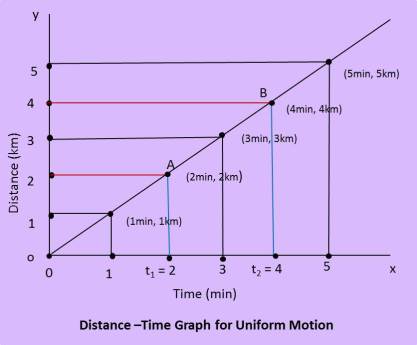
Above graph shows the set of points on the graph corresponding to positions of the car at various times.
(b) The distance time – graph for a car moving with non – uniform speed will not be a straight line.
Eg :-
Distance travelled by a car at regular time intervals are tabulated below –
| Time (Sec) | Distance (Metre) |
| 0 | 0 |
| 2 | 1 |
| 4 | 4 |
| 6 | 9 |
| 8 | 16 |
| 10 | 20 |
| 12 | 25 |
The graph is shown below –

(ii) Velocity – time graphs represent variation in velocity with time for an object moving in a straight line. Time is represented on the x – axis and velocity represented along y – axis.
(a) Velocity – time graph will be a horizontal straight line while moving with uniform velocity. Because velocity of the object will be constant and time will be change.
Eg:- Velocity and time of a moving car is tabulated below –
| Velocity (m/s) | Time (s) |
| 10 | 1 |
| 10 | 2 |
| 10 | 3 |
| 10 | 4 |
The velocity time graph for uniform velocity is showing below –

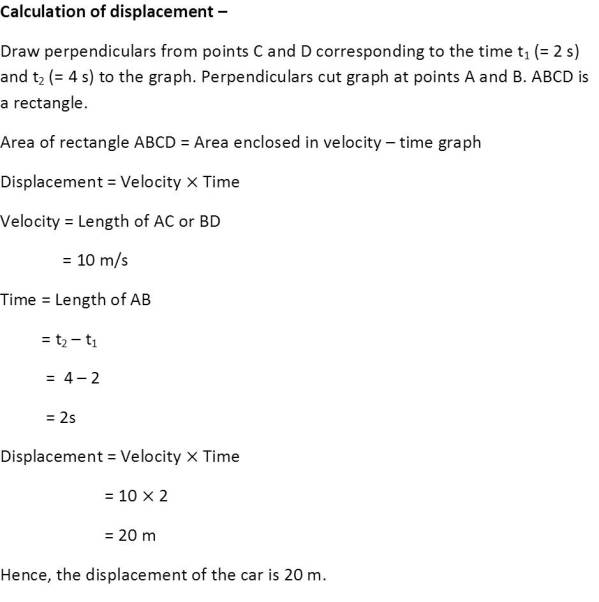
(b) Velocity – time graph will be a straight line passing through origin while moving with uniform acceleration. Because velocity of the object changes by equal amount in equal interval of time.
Eg:- Velocity of an c object at regular instants of time is tabulated below –
| Time (Sec) | Velocity of the object (m/s) |
| 0 | 0 |
| 5 | 2.5 |
| 10 | 5.0 |
| 15 | 7.5 |
| 20 | 10.0 |


(c) Velocity – time graph can have any shape while moving with non -uniform acceleration.
The shape of velocity – time graph while moving with non -uniform acceleration can have any shape. Two possible graphs are showing below –
(i)
The above graph represents the motion of an object whose velocity is decreasing with time.
(ii)
The above graph shows the velocity – time graph representing the non – uniform variation of velocity of the object with time.
(i) Equation for velocity – time relation – The velocity – time graph of an object that moves with an uniform acceleration is a straight line as represented below-

In graph,
The object moves from point A to point C.
Therefore,
Initial velocity of the object at point A, u = 0
Final velocity of the object at point B, v
Time taken by the object = t sec
The velocity changes from point A to B at the uniform rate (a) m/s2
x– axis
Draw perpendicular line BE from point B to x axis.
Initial velocity = OA
y – axis
Draw perpendicular line BC from point B to y axis.
Final velocity = OC
Change in velocity in time interval t, BD = BC – CD
Draw AD parallel to OC.
Therefore, AD = OC …(1)
BC = BD + DC
= BD + OA (From equation 1)
Let, time taken by object = AD = OC = t
 BD = at
BD = at
BC – CD = at
v – u = at
v = u + at
Eg:- A car starts from the rest and attain the velocity of 50 m/s. It moves with uniform acceleration and takes 1 hour to reach destination. Find its acceleration.
Ans-
Initial velocity = 0 m/s
Time taken = 1 hour
= 60 sec
Velocity of the car = 50 m/s
Let uniform acceleration of the car = a m/s2
v= u + at
50 = 0 + a(60)
50 = 60 a
a =
= .8333 m/s2
Hence, the car is moving with uniform acceleration .8333 m/s2.
(ii)Equation for position – Time Relation
Let the object has travelled a distance s in time t under uniform acceleration a.
In fig below,
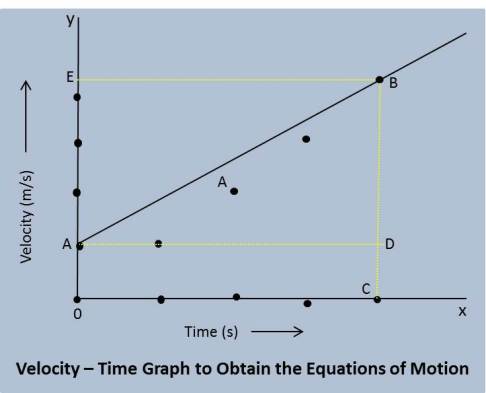


(iii)Equation for position – velocity relation
In graph below-
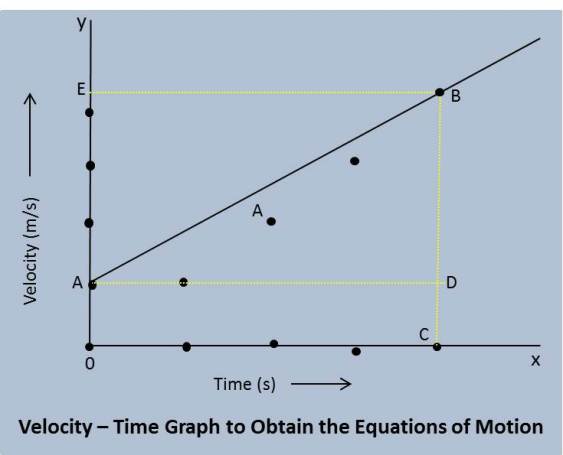

Eg:- An object starts with velocity of 10 m/s and distance travelled 2000 m. The object reaches to velocity 20 m/s with uniform accelerate. Find out the acceleration of the object.
Ans-
Initial velocity = 10 m/s
Final velocity = 20 m/s
Distance travelled by the object, s = 2000 m
Let acceleration of the object = a m/s2
2as = v2 – u2
2a(2000) = 202 – 102
4000a = 400 – 100
4000a = 300
a = .075 m/s2
Hence, the acceleration of the object is .075 m/s2.
(13)Uniform circular motion is the motion when an object moves in a circular path with uniform speed and changes its direction at the tangent of the circle at every point of the circle.
The object moves on circular path. Therefore, the distance travelled by the object is equal to the distance travelled by the object.
Circumference of the circle with radius r = 2 r
Time taken to travel circumference = t
Let the velocity of the object = v
 When the object moves on any other shape except circular path the object has to change its velocity at the corner of the path of different shape except circular path. Therefore, the object can move without changing its velocity moves only on circular path.
When the object moves on any other shape except circular path the object has to change its velocity at the corner of the path of different shape except circular path. Therefore, the object can move without changing its velocity moves only on circular path.
Eg:- A boy moves a stone tie on the thread continuously. Then he released his stone. The stone moves along a straight line tangential to the circular path. It shows that the direction of motion changed at every point when the stone was moving along the circular path.
Helping Topics
